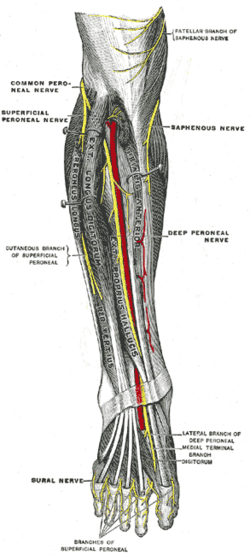|
Deep fibular nerve
The deep fibular nerve (also known as deep peroneal nerve) begins at the bifurcation of the common fibular nerve between the fibula and upper part of the fibularis longus, passes infero-medially, deep to the extensor digitorum longus, to the anterior surface of the interosseous membrane, and comes into relation with the anterior tibial artery above the middle of the leg; it then descends with the artery to the front of the ankle-joint, where it divides into a lateral and a medial terminal branch. StructureLateral side of the legThe deep fibular nerve is the nerve of the anterior compartment of the leg and the dorsum of the foot. It is one of the terminal branches of the common fibular nerve. It corresponds to the posterior interosseus nerve of the forearm. It begins at the lateral side of the fibula bone, and then enters the anterior compartment by piercing the anterior intermuscular septum. It then pierces the extensor digitorum longus and lies next to the anterior tibial artery, following the course of the artery until the ankle-joint where the nerve divides into medial and lateral terminal branches. In the leg, the deep fibular nerve divides into several branches:[1]
FootClose to the ankle joint, the deep fibular nerve terminates by dividing into medial and lateral terminal branches.[1]
FunctionIn the leg, the deep fibular nerve supplies muscular branches to the anterior compartment of extensor muscles in the leg which include the tibialis anterior, extensor digitorum longus, fibularis tertius, and extensor hallucis longus (propius), and an articular branch to the ankle-joint. After its bifurcation past the ankle joint, the lateral branch of the deep fibular nerve innervates the extensor digitorum brevis and the extensor hallucis brevis, while the medial branch goes on to provide cutaneous innervation to the webbing between the first and second toes. Clinical significanceDamage to the deep fibular nerve, as is possible with traumatic injury to the lateral knee, results in foot drop. The deep fibular nerve is also subject to injury resulting from lower motor neuron disease, diabetes, ischemia, and infectious or inflammatory conditions. Injury to the common fibular nerve is the most common isolated mononeuropathy of the lower extremity and produces sensory problems on the lateral lower leg in addition to foot drop.[3] Additional images
References
External links
|
||||||||||||||||||||||
Portal di Ensiklopedia Dunia






